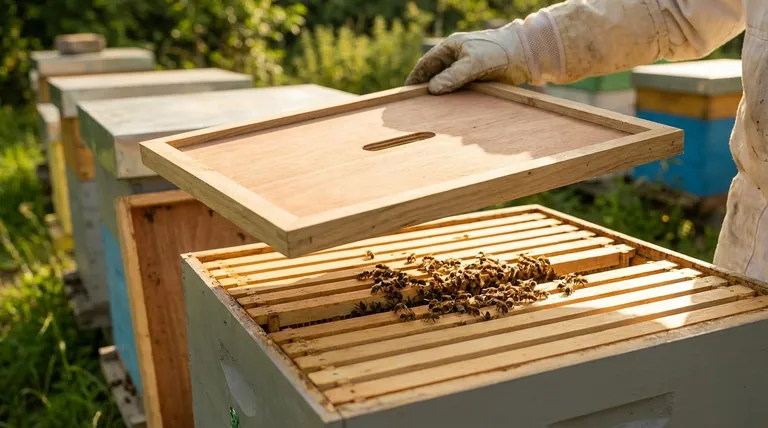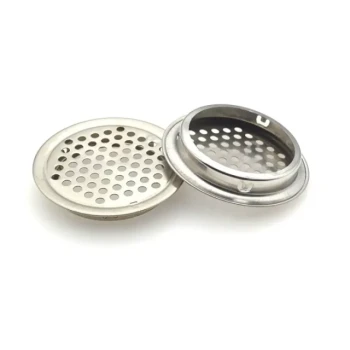At its core, the inner cover of a Langstroth hive is a multi-functional component that sits directly on top of the uppermost box and beneath the main telescoping cover. It serves as a crucial barrier that provides insulation, improves ventilation, and prevents the bees from sealing the hive shut with propolis, making hive management significantly easier.
The inner cover is not merely a secondary lid; it is a critical tool for managing the hive's internal environment. Its primary purpose is to create a pocket of still air that insulates the colony while allowing for moisture control and easier access for the beekeeper.

The Primary Roles of the Inner Cover
The inner cover's simple design belies its importance in maintaining a healthy and manageable colony. It addresses several fundamental needs of both the bees and the beekeeper.
Creating a Critical Air Barrier
The most important function is the creation of dead air space between the colony and the outer cover. This pocket of air acts as a powerful insulator.
In the summer, it shields the hive from the intense heat of direct sunlight. In the winter, it dramatically reduces heat loss from the top of the cluster, helping the bees conserve energy.
Preventing Unwanted Construction
Bees are naturally driven to seal any gaps in their hive with a sticky resinous substance called propolis. Without an inner cover, they would firmly glue the telescoping outer cover directly to the top bars of the frames.
This would make inspections nearly impossible without damaging the hive. The inner cover provides a predictable, smooth surface that prevents this, ensuring the beekeeper can access the colony with minimal disturbance.
Managing Internal Climate
Proper ventilation is essential for a healthy hive. The inner cover is vital for managing the flow of air and, more importantly, moisture.
It allows moisture-laden air from the bees' respiration to circulate and exit the hive, preventing dangerous condensation from forming and dripping down on the cluster, especially during cold winter months.
A Tool for Strategic Hive Management
Beyond its passive functions, the inner cover is actively used by beekeepers to perform essential tasks throughout the year.
Facilitating Supplemental Feeding
Most inner covers feature a central hole. This opening is perfectly designed for placing a feeder, such as an inverted jar of syrup, directly over the cluster.
This allows for efficient and targeted feeding without having to fully open and disrupt the hive.
Providing a Secondary Entrance
Many inner covers have a small notch on one of the rims. When oriented correctly, this notch creates a small upper entrance for the hive.
This secondary entrance can improve air circulation, reduce traffic congestion at the main bottom entrance, and give bees an escape route for moisture during winter.
Adapting for Seasonal Needs
The rim of the inner cover typically has two sides: a shallow side and a deep side. The shallow side provides standard bee space for most of the year.
In winter, flipping the cover to the deep side provides extra space above the frames. This space can be used to place a block of emergency fondant feed or to enhance ventilation and moisture control.
Why You Shouldn't Skip the Inner Cover
While a hive could technically exist without an inner cover, its absence creates significant problems that harm the colony and frustrate the beekeeper.
The Consequences of Omission
A hive without an inner cover will suffer from poor thermal regulation, making it harder for the colony to manage extreme temperatures.
Furthermore, the beekeeper will constantly struggle with an outer cover that is sealed shut with propolis and wax, leading to disruptive and damaging inspections. Moisture buildup also becomes a far more serious threat.
The Impact on Hive Health
The combination of poor insulation and high condensation creates a stressful environment for the bees. This can lead to increased disease, a smaller winter cluster, and a higher probability of colony loss.
The inner cover is a simple, low-cost component that directly contributes to the long-term health and stability of the colony.
Making the Right Choice for Your Goal
Effectively using the inner cover depends on your seasonal management goals.
- If your primary focus is overwintering success: Use the deep side of the inner cover to provide space for emergency food and ensure the upper entrance notch allows moist air to escape.
- If your primary focus is efficient summer inspections: The inner cover is non-negotiable, as it prevents the telescoping cover from being sealed shut with propolis.
- If your primary focus is supplemental feeding: Utilize the central hole for placing jar feeders, ensuring a secure and contained feeding system directly above the cluster.
Ultimately, the inner cover is an indispensable component that transforms a simple box into a well-regulated and manageable home for your bees.
Summary Table:
| Function | Key Benefit |
|---|---|
| Insulation | Creates a dead air space to regulate hive temperature in summer and winter. |
| Ventilation | Manages moisture and airflow to prevent dangerous condensation. |
| Propolis Barrier | Prevents bees from gluing the outer cover shut, making inspections easier. |
| Feeding Access | Central hole allows for easy placement of supplemental feeders. |
| Upper Entrance | Notch provides a secondary entrance for improved air circulation. |
| Seasonal Adaptation | Reversible rim adapts space for winter feeding or standard bee space. |
Equip your apiary for success with HONESTBEE.
As a trusted wholesale supplier to commercial apiaries and beekeeping equipment distributors, we provide the durable, high-quality components—like essential inner covers—that are fundamental to effective hive management and colony health.
Let us help you build a more resilient and productive operation. Contact our team today to discuss your supply needs and request a wholesale quote.
Visual Guide

Related Products
- Inner Beehive Cover for Beekeeping Bee Hive Inner Cover
- Professional Insulated Winter Hive Wrap for Beekeeping
- Stainless Steel Round Beehive Air Vents for Ventilation
- Long Langstroth Style Horizontal Top Bar Hive for Wholesale
- Professional Galvanized Hive Strap with Secure Locking Buckle for Beekeeping
People Also Ask
- What is the recommended orientation for the rim of an inner cover? Master Hive Ventilation and Insulation
- How is the inner cover used to promote ventilation? Master Hive Climate Control for Healthy Bees
- What is the role of inner covers in insulated beehives? Master Moisture Control for a Healthy Colony
- What is the function of an inner cover in a beehive? Essential for Hive Health & Management
- What is the function of the center hole in the inner cover? Master Hive Ventilation and Feeding



















